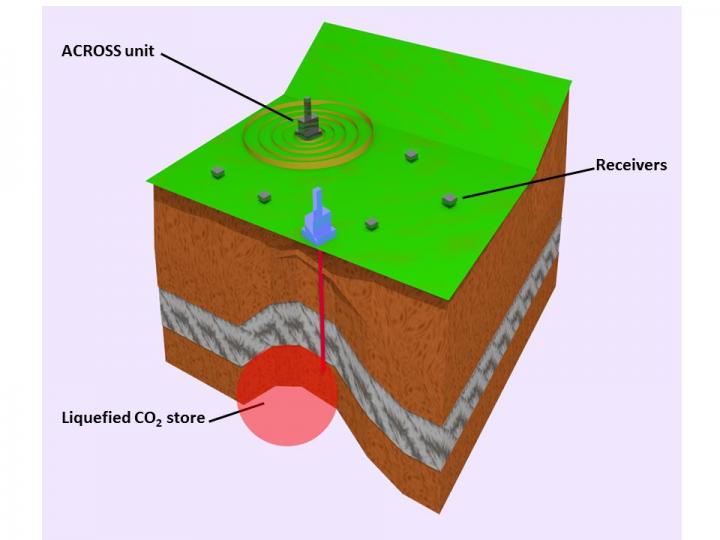Breakthrough in continuous monitoring of CO2 leaks from storage sites could assist CCS

Analyzing seismic waves generated by an Accurately Controlled Routinely Operated Signal System (ACROSS) unit can reveal information about the amount and location of CO2 leakage from an underground store. Credit: International Institute for Carbon-Neutral Energy Research (I²CNER), Kyushu University
Carbon capture and storage projects rely on effective monitoring of injected CO2. However, the high number of necessary surveys makes this a costly endeavor.
A team of Japanese researchers may have found a means of achieving easier and lower-cost monitoring for leaks of CO2 stored in underground reservoirs.
A recently published article from a team led by researchers at Kyushu University's International Institute for Carbon-Neutral Energy Research (I2CNER) shows how underground CO2 storage sites could be continuously monitored for leaks–a breakthrough for monitoring applications.
Underground storage of CO2 produced from fossil fuel burning, rather than releasing it into the atmosphere, could play an important role in suppressing climate change. However, to safeguard those living at the surface and regulate the climate, ensuring that the CO2 does not leak from the storage site is key.
Current monitoring methods are costly and only carried out periodically, but by using techniques more often used to study earthquakes and volcanic eruptions, the team used analysis of seismic waves to show it is possible to detect movement of subterranean fluids and to identify leaks before they reach the surface.
“One of the main issues” lead author Tatsunori Ikeda says, “was that we had to be sure we could distinguish between seismic wave signals from a CO2 leak and noise from other near-surface disturbances.”
Drawing on previous work across multiple disciplines, the method was developed and rigorously analyzed using computer simulations, before being field-tested near a busy road in central Japan's Tokai region. “We used an ACROSS unit and a series of geophones to test the method,” coauthor Takeshi Tsuji says.
Given the success of the experiment, “a real opportunity for application of this work is that microseismic monitoring arrays typically installed at storage sites could provide the data needed to identify any leakages and decrease the need for more costly 4D seismic studies that are the industry norm.”
Additional testing to refine the method and further improve its accuracy is one branch of work being carried out as part of I2CNER's interdisciplinary efforts to advance the development of carbon capture and storage and boost efforts for achieving a carbon-neutral society.
Media Contact
All latest news from the category: Earth Sciences
Earth Sciences (also referred to as Geosciences), which deals with basic issues surrounding our planet, plays a vital role in the area of energy and raw materials supply.
Earth Sciences comprises subjects such as geology, geography, geological informatics, paleontology, mineralogy, petrography, crystallography, geophysics, geodesy, glaciology, cartography, photogrammetry, meteorology and seismology, early-warning systems, earthquake research and polar research.
Newest articles

NASA: Mystery of life’s handedness deepens
The mystery of why life uses molecules with specific orientations has deepened with a NASA-funded discovery that RNA — a key molecule thought to have potentially held the instructions for…

What are the effects of historic lithium mining on water quality?
Study reveals low levels of common contaminants but high levels of other elements in waters associated with an abandoned lithium mine. Lithium ore and mining waste from a historic lithium…

Quantum-inspired design boosts efficiency of heat-to-electricity conversion
Rice engineers take unconventional route to improving thermophotovoltaic systems. Researchers at Rice University have found a new way to improve a key element of thermophotovoltaic (TPV) systems, which convert heat…



